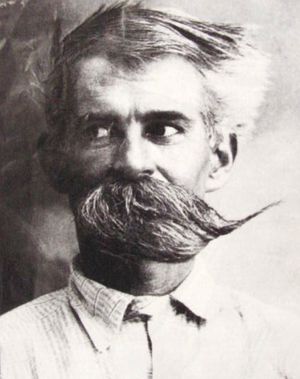The One Who Was
(photo of George Ohr courtesy Ohr-O'Keefe Museum)
Once, over a cup of coffee, late into the evening when confidences are easily shared, a friend leaned close to me and said, “I am meant for something special. I know I am. Since I was a little girl I’ve believed I was meant to do something significant.” She stirred the coffee in her cup, silent for a moment, before adding in a frustrated whisper. “ I just wish to hell I knew what it was.”
My friend, who spends each day trapped in middle-management purgatory, was worried that she was running out of time. That she might have missed her chance to be whatever it was she was meant to be. It is a uniquely human condition.
Just the other day, standing in a museum on the sugar white coast of Mississippi, I remembered her words.
I was in Biloxi for the opening of the Ohr-O’Keefe Museum. A place that will hold, among other treasures, pieces made by Biloxi’s driven and eccentric potter, George Ohr.
Ohr, in the jargon of the South, was a character. A man who was consumed by his passion for throwing pots and creating one-of-a-kind pieces. Reading about him, I was struck by his description of what happened the first time he put his hands on clay.
“When I found the potter’s wheel I felt it all over like a wild duck in water,” he wrote.
It was then that I remembered what my friend had said. Like so many, she’s still looking for that kind of experience.
Ohr’s story is compelling. Recognizing his fate the moment he touched clay, he was consumed by it. He threw himself into making difficult and unusual pieces. “I had to do lots of work and hard and heavy,” he wrote. “But all is light and easy when the will and love of it is there and when one gets really enthusiastic they will forget to get hungry.”
Ohr recognized his gift when he held it in his hands. And, he believed in the power of what he’d made. In spite of the constant struggle for financial success, he archived much of his work it, refusing to sell his best pieces, preferring instead to keep his collection intact. He stored 8,000 pieces, telling his family that the work was to be kept until the time when the collection “may be purchased by the nation.”
Each of us searches, some throughout an entire lifetime, for the thing that will make us sing. For the passion that will ignite and inspire us. My friend, in her midnight confession, admitted she still longs to find the spark that will light the same kind of flame inside her.
Reading about George Ohr, I admired his conviction that he was doing what he was meant to do. On a wall just inside the museum, next to the gift shop, there is a large photograph of Ohr. He is upside down, his feet pointed up to the ceiling. Beside the photo, is this quote.
“This pot is here and I am the potter who was.”
Change a word or two and it could be the message any of us hopes to leave behind. This painting is here and I am the painter who was. This book is here and I am the writer who was. This symphony. This scientific discovery. This marriage. These children. This love.
Even Frank Gehry, the great architect who designed the museum could confess to the same desire: This building is here and I am the architect who was.
I left the museum an admirer of a potter who is long gone, but whose work remains.
He was.
Cheryl-Anne Millsap writes for The Spokesman-Review. Her essays can be heard on Spokane Public Radio and on public radio stations across the country. She is the author of “Home Planet: A Life in Four Seasons” and can be reached at catmillsap@gmail.com
